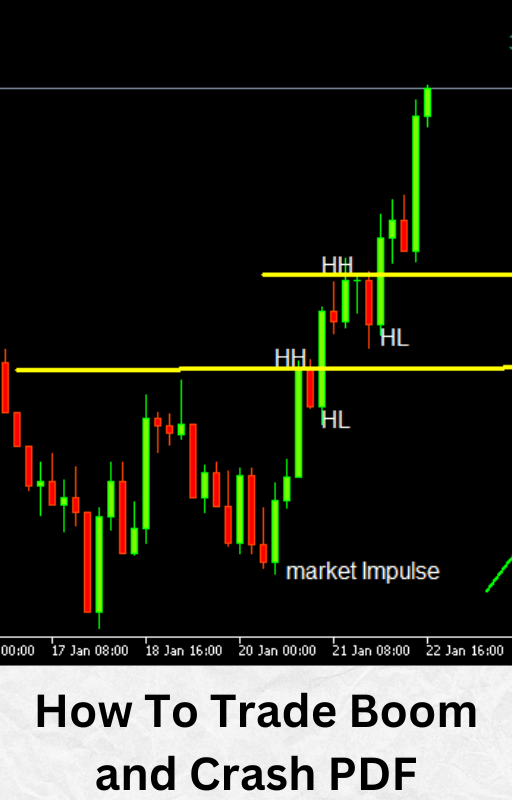Deriv’s exclusive index, Boom and Crash, exhibits a unique movement distinct from currencies, remaining impervious to global events.
Achieving success in Deriv synthetic indices trading hinges on grasping the underlying trading principles.
To elevate your trading skills, explore the “How to Trade Boom and Crash PDF”, a comprehensive guide designed to propel your trading endeavors to new heights.
Within this document, discover advanced techniques for honing in on high-yield market setups by meticulously selecting your entries.
Emphasizing post-market analysis from a broader time frame, the PDF equips traders with insights to navigate the intricacies of Boom and Crash trading, enhancing their ability to make informed and strategic decisions in this exclusive Deriv market.
UNDERSTANDING DERIV BOOM AND CRASH
Before delving into trading strategies, it’s crucial to understand the nature of Deriv’s Boom and Crash index. This synthetic index simulates market volatility through rapid price movements.
Boom represents a bullish phase with rapid upward movements, while Crash mirrors a bearish phase with sharp declines.
Traders can capitalize on both bullish and bearish trends, making Boom and Crash a versatile instrument for profit generation.
HOW TO TRADE BOOM AND CRASH PDF

To master Boom and Crash trading, this is what you will get to learn in the PDF
- How to tell the Dominant trend
- How to identify a base
- What time frame is best for entry
- When to place a trade
- How to set stop loss

HOW TO UNLOCK PROFIT POTENTIAL IN DERIV BOOM AND CRASH TRADING: A STRATEGIC APPROACH
Deriv’s Boom and Crash stands out as an exclusive index, offering a unique avenue for traders seeking profit opportunities.
In this comprehensive guide, we’ll delve into the intricate world of trading Boom and Crash on Deriv, emphasizing the significance of higher time frames and market top-down analysis.
Unlike traditional markets, Boom and Crash remain impervious to global events, making it an attractive playground for technical traders.
This guide aims to equip you with the knowledge and strategies needed to navigate this dynamic market and maximize your earning potential.
THE APPEAL OF BOOM AND CRASH FOR TECHNICAL TRADERS
One of the key attractions of Boom and Crash is its immunity to global events. Unlike traditional markets influenced by geopolitical factors, economic indicators, and other external forces, Boom and Crash operate independently.
This autonomy makes it an ideal playground for technical traders who rely on charts, patterns, and technical indicators to make informed decisions.
By eliminating the noise of global events, traders can focus on pure technical analysis, enhancing their ability to predict price movements accurately.
The Role of Higher Time Frames in Decision-Making:
GAINING A BROADER PERSPECTIVE
To make informed decisions in Boom and Crash trading, it’s essential to incorporate higher time frames into your analysis.
Higher time frames, such as daily or weekly charts, provide a broader perspective of the market trends.
This macro view helps traders identify significant support and resistance levels, overarching trends, and potential reversal points.
IDENTIFYING KEY SUPPORT AND RESISTANCE LEVELS
Higher time frames allow traders to identify robust support and resistance levels that may influence price movements in the Boom and Crash index.
These levels act as crucial reference points, guiding traders in setting entry and exit points.
By focusing on the bigger picture, traders can avoid getting trapped in short-term fluctuations and align their strategies with more substantial market dynamics.
Market Top-Down Analysis for Boom and Crash Trading
STARTING WITH THE BIG PICTURE: MONTHLY AND WEEKLY ANALYSIS
Market top-down analysis involves examining the market from higher time frames to lower time frames, providing a holistic view of the prevailing trends.
Begin your analysis with monthly and weekly charts to identify long-term trends in Boom and Crash. This step sets the foundation for understanding the broader market context.
ZOOMING IN: DAILY AND INTRADAY ANALYSIS
After establishing the long-term trends, zoom in on daily and intraday charts for more granular insights. Look for patterns, key levels, and potential entry points based on the information gathered from higher time frames.
This step helps refine your trading strategy and align it with both short-term and long-term trends.
UTILIZING MULTIPLE TIME FRAME ANALYSIS
Combine information from various time frames to create a comprehensive trading plan.
For example, if the monthly chart signals a long-term uptrend, and the daily chart indicates a short-term pullback, you can fine-tune your entry points and manage risk more effectively.
Multiple time frame analysis adds depth to your decision-making process, increasing the probability of successful trades.
STRATEGIES FOR BOOM AND CRASH TRADING
Trend Following Strategies:
MOVING AVERAGES:
Use simple or exponential moving averages on higher time frames to identify the prevailing trend.
Trade in the direction of the trend to maximize the probability of profitable trades.
TRENDLINES:
Draw trend lines on higher time frames to visualize the overall trend. Look for opportunities to enter trades when prices bounce off these trend lines.
SUPPORT AND RESISTANCE TRADING
Horizontal Levels: Identify significant support and resistance levels on higher time frames. Plan your trades around these levels, considering potential reversals or breakouts.
Fibonacci Retracement: Apply Fibonacci retracement levels on higher time frames to pinpoint potential reversal zones. Combine these levels with other technical indicators for confirmation.
PRICE ACTION STRATEGIES
Candlestick Patterns: Master candlestick patterns on higher time frames to gauge market sentiment. Engulfing patterns, doji, and hammers can provide valuable insights into potential trend reversals or continuations.
RISK MANAGEMENT
Position Sizing: Determine the appropriate size for each trade based on your risk tolerance and overall portfolio size. Avoid overleveraging, and set stop-loss orders to manage potential losses effectively.
Diversification: Spread your risk across multiple trades and assets to mitigate the impact of a single loss. Diversification is a key component of a robust risk management strategy.
Overcoming Challenges in Boom and Crash Trading
VOLATILITY MANAGEMENT
Adaptability: Boom and Crash are inherently volatile, requiring traders to be adaptable. Stay vigilant and adjust your strategy as market conditions evolve.
Use of Volatility Indicators: Incorporate volatility indicators, such as the Average True Range (ATR), to gauge the level of market volatility. Adjust your position sizes and risk parameters accordingly.
EMOTIONAL DISCIPLINE
Stick to the Plan: Develop a trading plan based on your analysis and strategy. Stick to the plan, even in the face of emotional impulses. Emotional discipline is crucial for long-term success.
CONTINUOUS LEARNING
Stay Informed: The financial markets are dynamic, and continuous learning is essential.
Stay informed about market developments, new trading strategies, and updates from Deriv to refine your skills and adapt to changing conditions.
CONCLUSION
When trading Deriv Boom and Crash trading, success hinges on a strategic approach that leverages higher time frames and market top-down analysis.
The index’s immunity to global events presents a unique opportunity for technical traders to thrive in a controlled and predictable environment.
By integrating these strategies and emphasizing risk management, traders can navigate the complexities of Boom and Crash, unlocking the full profit potential and sustained success in this exclusive Deriv synthetic index.



Leave a Reply